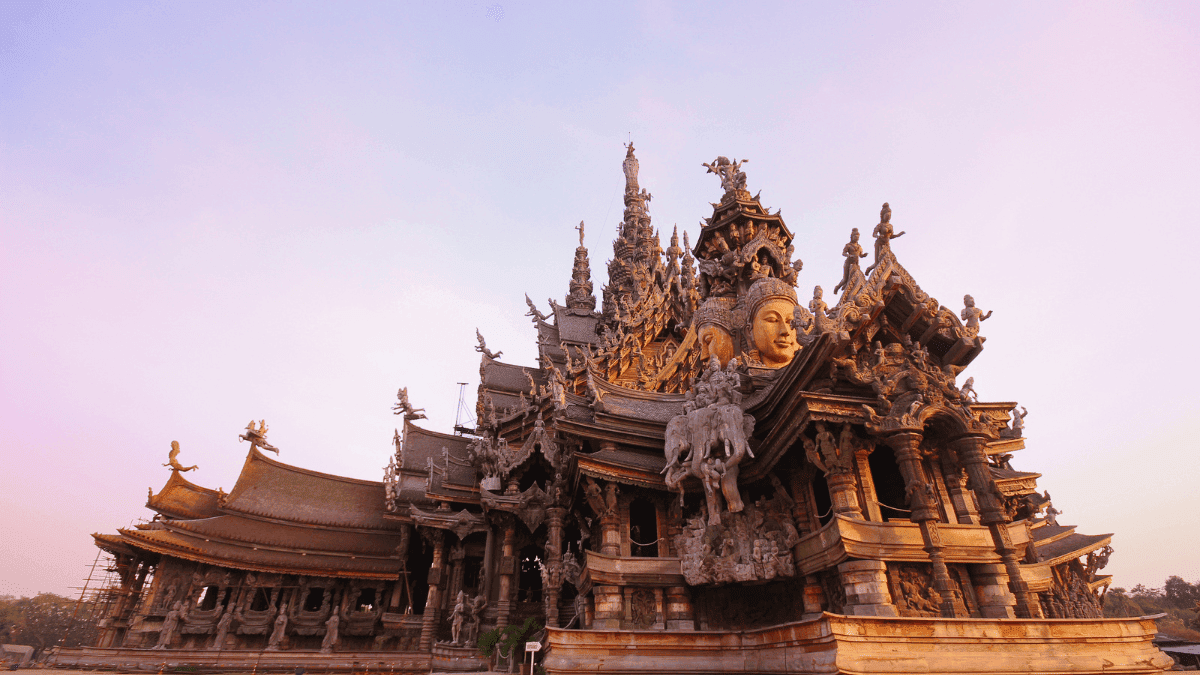Are you planning your trip to Thailand and don’t know which temples to include? Here are the temples of Thailand you can’t miss on your trip.
Steeped in rich Buddhist traditions, Thailand is home to ornate temples known for their grandeur and spiritual significance. With over 40,700 temples (known as “wats”) all over the country, you won’t run out of impressive historical spots to explore. These fantastic cultural sites display glorious religious figures and are wonderfully painted in bright, eye-catching colors.
Read on to discover the unique origins and features of 26 must-visit Thai temples. Each is a spectacular work of art depicting tales of empires long gone.
26 Marvelous Thai Temples To Check Off Your Bucket List
1. The Sanctuary of Truth
The 344-foot (105-meter) tall Sanctuary of Truth is a remarkable showcase of ancient woodcarving techniques. Wooden sculptures devoted to icons of Thai, Khmer, Chinese, and Indian faith are featured in four separate wings.
The temple is in North Pattaya, Bang Lamung, Chon Buri. The entrance fee of 500 Thai Baht (14 US dollars) includes a guided tour of the temple, open from 8:40 a.m. to 5 p.m. daily.
2. Wat Boromracha Kanchanapisek Anusorn
Chinese Buddhists built Wat Boromracha Kanchanapisek Anusorn to honor the 50th anniversary of King Bhumibol’s ascension to the throne. Its walls, ceilings, and floors were meticulously decorated with beautiful engravings.
It is open from 8 a.m. to 5 p.m. and can be found in Bang Bua Thong District, north of Bangkok. You can enter for free, although small donations are encouraged.
3. Wat Samuha Pradit Tharam
The Wat Samuha Pradit Tharam temple used to hold ceremonies for civil servants. Inside, you will see murals illustrating Khawi folk tales and bronze images of Lord Buddha and his disciples.
Opening hours are from 8:30 a.m. to 4:30 p.m. To visit the site, visit the central province of Saraburi, 60 miles (97 kilometers) from Bangkok, accessible by taxi, bus, and train.
4. Wat Wang Wiwekaram
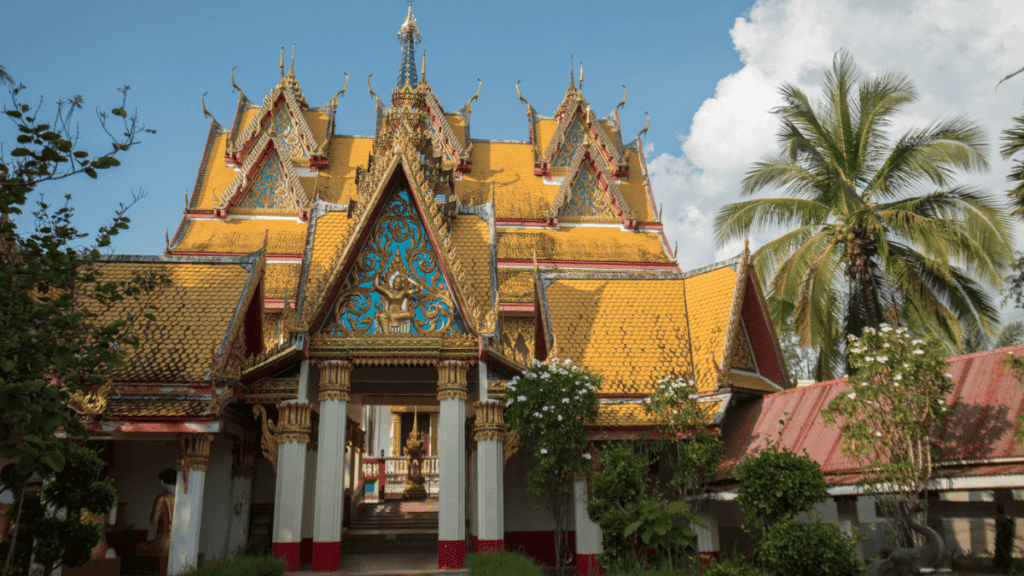
Wat Wang Wiwekaram is dedicated to Luang Phaw Uttama, a monk who protected the Mon people during his time. His remains lie here alongside marble Buddha sculptures. The grounds have a peaceful atmosphere, and the temple boasts elegant columns and roofs.
It is located in Sangkhlaburi District, Kanchanaburi province (accessible by a 3-hour bus or train ride from Bangkok) and is open from 8 a.m. to 5 p.m.
5. Wat Si Chum (The Huge Ancient Buddha or Temple of the Bodhi Tree)
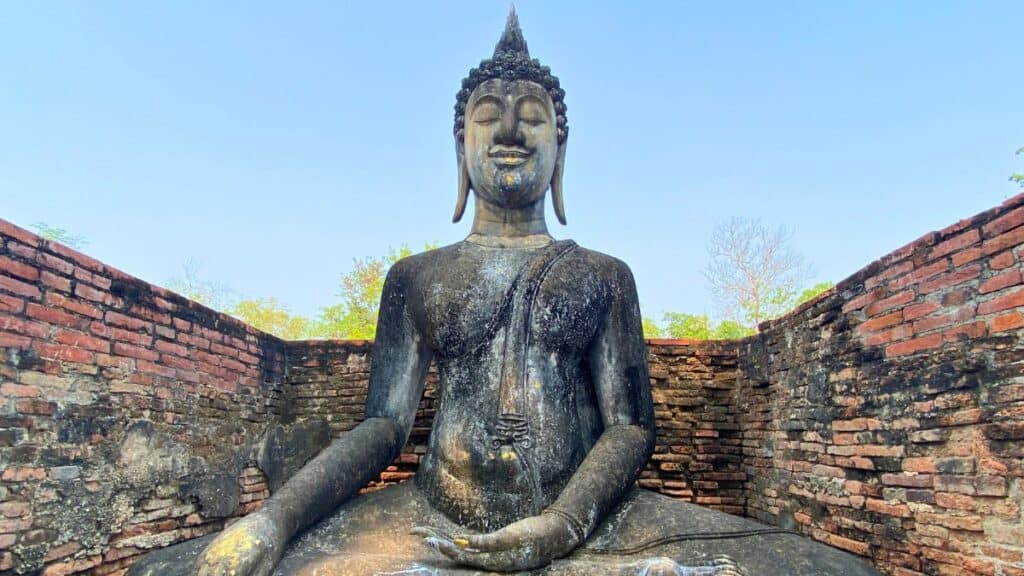
Wat Si Chum is a 13th-century structure notable for its sacred meanings, as you will come across many surrounding Bodhi trees (revered in Buddhism as the ‘tree of enlightenment’) and a giant seated figure of Buddha named ‘Phra Achana’ (which translates to ‘Buddha who is not afraid’).
You can visit Wat Si Chum at the Sukhothai Historical Park (2 bus stops from Chiang Mai). It is open from 6 a.m. to 5 p.m.
6. Wat Pak Nam (The New Big Buddha of Bangkok)
There are many reasons to visit the royal temple of Wat Pak Nam, founded in 1610. Here, you can browse a museum of artifacts and relics, see gold statues on display, and marvel at a big emerald-green pagoda lighting up a mural on the ceiling. Its main attraction, however, is a 226-foot (69-meter) tall Buddha statue that compels visitors to pause and take a moment to reflect. Visitors might also encounter monks deeply engaged in meditation.
If you’re planning a day trip to the shrine, remember that it opens at 8 a.m. and closes at 6 p.m. It’s just a 10-minute walk from Bangkok’s Bang Phai station and next to the Chao Phraya River. Entrance is free, but donations are welcome.
7. Wat Phanom Rung (The Big Mountain)
Wat Phanom Rung is a cultural heritage site with well-preserved terraces and pathways that will take you back in time. The entire sanctuary is situated beside an extinct volcano and was made from pink sandstone. After it was first constructed, it went through multiple renovations between the 10th and 13th centuries.
Don’t miss the chance to cross the Naga Bridge, which represents the connection between heaven and earth.
The temple complex is located in Chaloem Phra Kiat, Buri Ram, 255 mi (410 km) from Bangkok via taxi, bus, or train, and is open from 7 a.m. to 6 p.m. You need to pay 100 THB ($3) to enter.
8. Prasat Hin Phimai
Built in the 11th century, this temple stands on the Ancient Khmer Highway and is a prime example of classical Khmer architecture. History buffs will probably notice that the temple resembles Angkor Wat. Indeed, they have similar designs and were constructed with the same materials: bricks, sandstone, and laterite.
The historic grounds are in Nakhon Ratchashima City’s Phimai district (reachable from Bangkok via Mochit Central Bus Terminal). It opens at 9 a.m. daily and closes at 4 p.m. The entry fee is 100 THB ($3).
9. Wat Sri Suphan (The Silver Temple)
As the name suggests, this exquisite temple is known for its shiny silver exterior. It was built during the 16th century when the Mangrai dynasty took over Thailand. The iconic building’s delicate carvings were doused in aluminum and silver, giving it a royal aura.
This temple on Wualai Road, Tambon Hai Ya, Chiang Mai. You may visit from 6 a.m. to 6 p.m., but the temple stays open on Saturdays until 11 p.m.
10. Wat Phra Prang Sam Yot (The Monkey Temple)
Wat Phra Prang Sam Yot is a striking landmark made of brick that holds religious value as an active prayer site. It was built in the 13th century with three towers representing deities of the Hindu faith and was later converted into a Buddhist temple during King Narai’s rule. At present, macaque monkeys populate the temple grounds, drawing in hoards of tourists.
The Monkey Temple is on Vichayen Road in Lop Buri, easily accessible by train from Bangkok’s Hua Lampong station. The entrance fee is 30 THB ($1), and its operating hours are from 8 a.m. to 6 p.m.
11. Wat Samphran (The Temple of the Dragon)
Make your trip to Thailand even more memorable by visiting Wat Samphran, which has a giant dragon statue wrapped around the 17-story-tall pink tower. The circling dragon represents a human’s journey from suffering to happiness, embodying the Buddhist concept of ‘karma.’ Inside the cylinder-shaped building is a spiral staircase to the top.
The temple is in the Amphoe Sam Phran district of the Nakhon Pathom province. It is open daily to the public from 6 a.m. to 6 p.m. You can enter the place for free, though donations are appreciated.
12. Wat Phra Kaew (The Temple of the Emerald Buddha)
Construction of the Wat Phra Kaew temple began in 1783 when King Rama I ordered a complex to be built for religious events. It is famous for housing the 26-inch-tall (66 cm) Emerald Buddha, one of the most revered symbols in the country. Three times a year, the Thai king changes the Emerald Buddha’s cloak, signifying a change in seasons. Right next to Wat Phra Kaew is the historic Grand Palace, where Thai royalty used to roam.
This temple can be found along Th Na Phra Lan in Bangkok. It is open daily from 8:30 a.m. to 3:30 p.m. and costs 500 THB ($14) for foreigners to enter.
13. Wat Rong Khun (The White Temple)
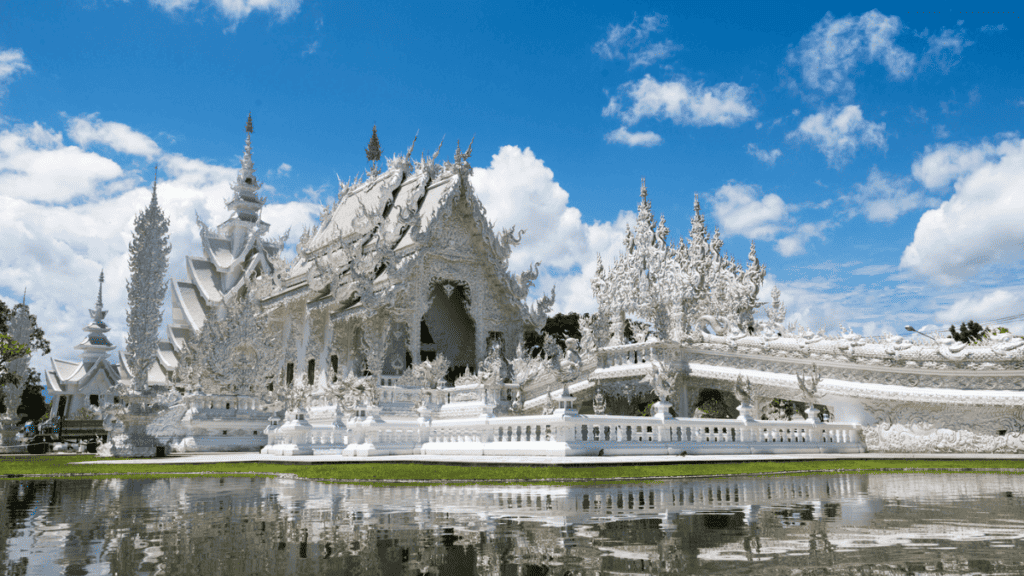
As soon as you spot the sacred temple Wat Rong Khun, you’ll understand why it’s so popular among tourists—its majestic white structures make it stand out among other destinations. Its stunning, detailed architecture and glimmering white color symbolize Buddha’s purity. Chalermchai Kositpipat, a famous Thai architect, designed this highly recognizable temple compound.
Travel 9.3 mi (15 km) southwest of Chiang Rai to reach The White Temple. Entry costs 80 THB ($2). It opens at 8 a.m. and closes at 6 p.m. daily.
14. Wat Tham Sua (The Tiger Cave Temple)
Adventure seekers will not want to pass up this challenge. To arrive at Wat Tham Sua, you must conquer 1,237 steps up a hill. A monumental, shining Buddha statue rests on the peak of the main terrace. The hilltop also offers breathtaking views of the lush valley for perfectly rejuvenating moments after the climb.
The Tiger Cave Temple is 12.4 mi (20 km) from Krabi. We suggest making your ascent up the summit early in the morning or late in the afternoon to avoid the harsh sun. Entrance to the temple is free, although you may donate a small amount.
15. Wat Saam Prasob (The Sunken Temple)
1968 Wat Saam Prasob was entirely submerged in water when a dam was built nearby. Part of the temple remains underwater today, so travelers must wait for waters to subside (sea levels vary depending on the time of year) before making offerings at the altar.
You can visit the site at Sangklaburi, Kanchanaburi (a 3.5-hour bus ride from Bangkok).
16. Wat Rong Suea Ten (The Blue Temple)
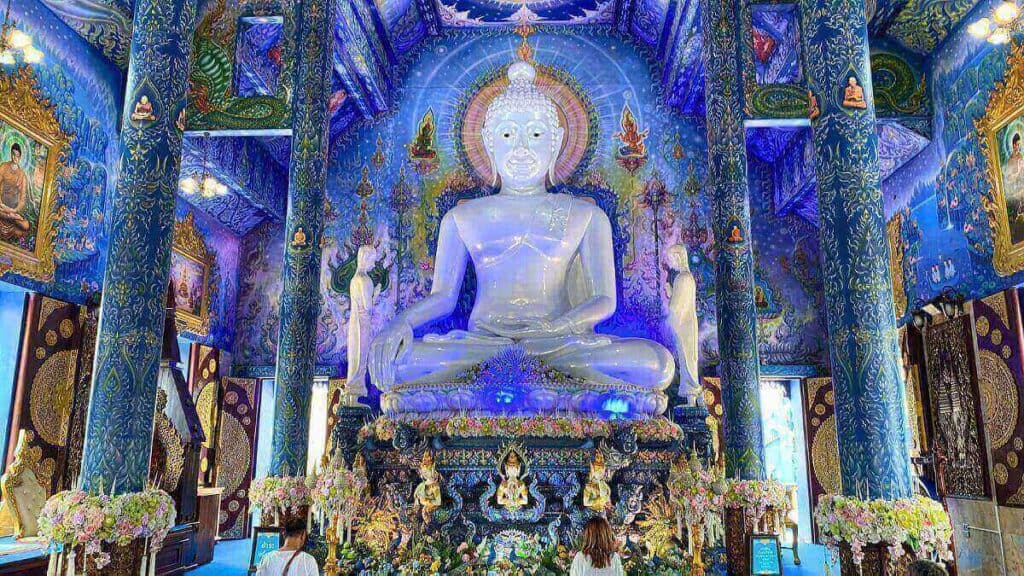
This temple’s picturesque, vivid shades make it especially notable—the blue and gold hues outside delightfully contrast the pure white Buddha statue inside the chapel.
Wat Rong Suea Ten is one of the newest temples in Chiang Rai, so don’t miss your chance to make a stop here. Its opening hours are from 7 a.m. to 8 p.m.
17. Phra Maha Chedi Tripob Trimongkol (The Stainless Steel Temple)
Passersby will immediately notice something special about this cultural place: its contemporary stainless steel design reflects sunlight, making it shine brightly. Also, the wind chimes on the top floor add a pleasant touch.
Roam the wat freely at any time from 7 a.m. to 10 p.m. It is in Kho Hong, Hat Yai District, Songkhla Province.
18. Wat Ban Rai (The Elephant and Turtle Temple)
Wat Ban Rai, made of ceramic tiles, features an amusing design—from the ground level, it appears to be shaped like an elephant but resembles a turtle from a top-down viewpoint.
Find this temple at Laem Fa Pha, Amphoe Phra Samut Chedi, Samut Prakan, around 24.9 mi (40 km) from Bangkok. You can visit from 8 a.m. to 5 p.m.
19. Wat Noy (The Smallest Temple in Thailand)
‘Noy’—meaning ‘small’—is the perfect word for this temple. At just 10 ft (3 m), it was forged by the former ruler of Nan during the 1800s. Today, the white limestone shrine is known as the smallest in the country.
Wat Noy is on Pakong Road, Nai Wiang Sub-district, Muang Nan District, near the Nan National Museum.
20. Wat Tilok Aram (The Temple of the Lake)
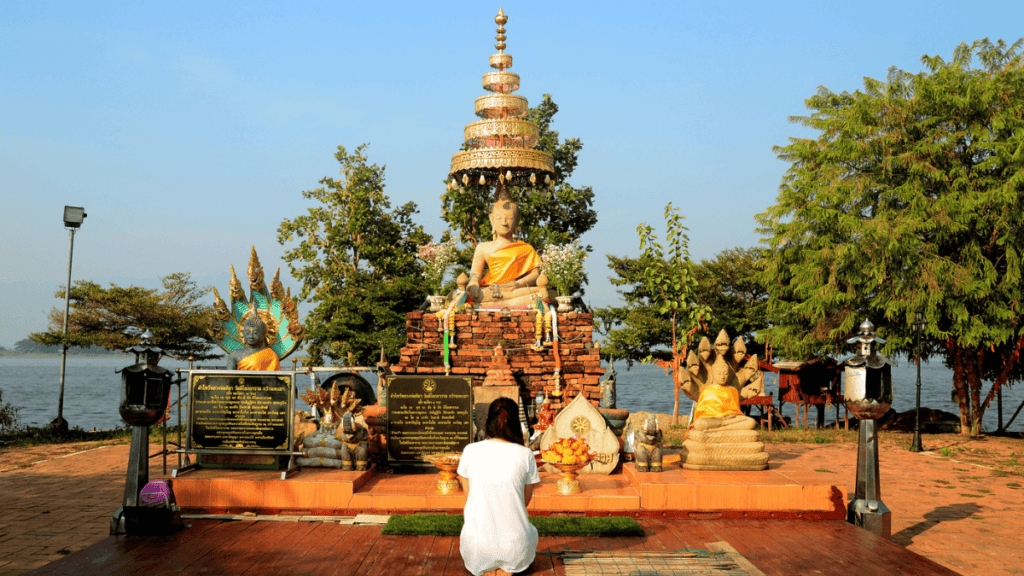
Wat Tilok Aram is over 500 years old. This venerable sanctuary rests on a tiny island in the middle of a lake; thus, it is only accessible by boarding a boat from the pier. Renting a row boat costs 20 THB ($0.50) while renting a pedal boat costs 40 BHT ($1).
The temple is at Phayao Lake in Phayao Province, northern Thailand.
21. Wat Khun Samut Chin (The Temple Surrounded by the Sea)
Rising sea levels have drastically changed Wat Khun Samut Chin’s appearance, as it is partially sunken in seawater. If you’re lucky enough to be close by during low tide, take advantage of the opportunity to visit the holy site.
It is located at Laem Fa Pha, Amphoe Phra Samut Chedi, Samut Prakan, around 24.9 mi (40 km) southeast of Bangkok.
22. Wat Bang Kung (The Banyan Tree Temple)
One of the first things you’ll notice about Wat Bang Kung is the Banyan tree roots enveloping the building. The Banyan tree grew after the temple’s construction during the Ayutthaya period in 1351. Now, you can wander around the historic grounds while keeping an eye out for the Buddha statue hidden within the sturdy roots.
Wat Bang Kung is in the Bang Khontee district of Samut Songkhram, Thailand’s smallest province. It’s open daily from 7 a.m. to 5 p.m. with free admission.
23. Wat Larn Kuad (The Million Bottle Temple)
If you like learning about environmentally friendly practices, Wat Larn Kuad will surely appeal to you. The mosaic designs on the exterior are made up of recycled glass bottles and bottle caps, making the green-colored temple shimmer in the daylight. Monks started collecting these bottles in 1984 and spent around two years covering the temple’s concrete frame with recycled materials.
The Million Bottle Temple is in the Khun Han District of Si Saket. It operates from 8 a.m. to 5 p.m. and offers free entry.
24. Wat Sirindhorn Wararam (The Temple That Glows in the Dark)
Visit Wat Sirindhorn Wararam at night to see what makes it one-of-a-kind: fluorescent paint on the ground and walls reveals an illuminated image of the ‘Tree of Life,’ embellished with intricate patterns that glow in the dark. The temple’s luminous decorations are an unforgettable mystical sight.
Travelers who drop by Wat Sirindhorn Wararam can also take in a serene hilltop view overlooking the border between Thailand and Laos on the edge of Ubon Ratchathani. Entrance to the temple is free.
25. Wat Pa Dong Rai (The Lotus Flower Temple)
Wat Pa Dong Rai, built in the middle of a lake, is shaped like a lotus flower, hence the name. Here, you can bask in the peaceful surroundings and enjoy a soothing lake view. Inside the dome, you’ll see colorful murals picturing the lives of Buddha and a ceiling lined with gold ornaments.
Wat Pa Dong Rai is 37.3 mi (60 km) east of Udon Thani City. You may enter for free, but voluntary donations go towards the site’s upkeep.
26. Wat Pa Phu Kon (The Colorful Temple on the Hill)
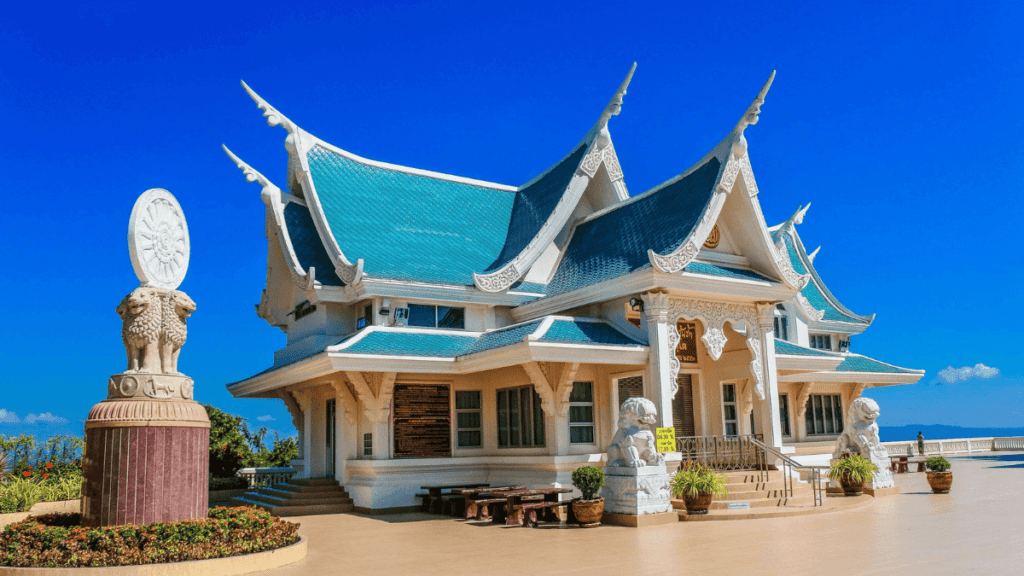
The Colorful Temple on the Hill boasts a 65-foot (20-meter) long image of the reclining Buddha made from white marble blocks from Italy. The central building and smaller pavilions are all painted blue and lined with gold detailing. Construction of this temple is said to have cost 320 million THB ($9 million).
You will find this temple in Na Yung Nam Som National Park, about 75 mi (120 km) from Udon Thani. It is open from 8:30 a.m. to 5 p.m. daily, and visitors can enter for free.
Things to Remember When Visiting Thai Temples
Temples serve as solemn spaces and hold religious value for locals, so respect is important. Here are a few tips on the proper etiquette for visiting Thai temples, as well as some general reminders for your trip:
- Remove your shoes and hats before entering a temple.
- Wear clothes that cover your knees and shoulders (no tank tops, short skirts, etc.). In Thai culture, displaying modest attire is regarded as a gesture of respect.
- Bring extra drinking water to stay hydrated.
- Put on sunblock before going outdoors to reduce the risk of sun damage.
- Carry an umbrella to protect yourself from hot, sunny weather.
- Remember that temples near bodies of water, such as Wat Tilok Aram (The Temple of the Lake) and Wat Khun Samut Chin (The Temple Surrounded by the Sea), are unreachable when water levels rise due to climate. If you want to visit these temples, we recommend quickly researching when they become accessible.
Frequently Asked Questions – Temples of Thailand
What Are Temples in Thailand Called?
Temples in Thailand are called “wats.” The term “wat” is derived from the Pali word “vāṭa,” which means “enclosure” or “monastery.” Wats are places of worship and serve as important centers for Buddhist religious activities, meditation, education, and community gatherings.
They are often characterized by their ornate architecture, intricate decorations, and iconic features such as pagodas, statues of Buddha, and prayer halls.
Why Is Thailand Famous for Temples?
Thailand is famous for its temples and its deep-rooted devotion to Buddhism. These temples are not only places of worship but also social hubs where communities gather to celebrate religious events and seek spiritual guidance. Visiting temples in Thailand is a great way for travelers to learn about the country’s rich cultural heritage.
What Is the Most Sacred Temple in Thailand?
Wat Phra Kaew (The Temple of the Emerald Buddha) is considered one of the most sacred temples in Thailand. It is a pilgrimage site for those who wish to pay respects to the Emerald Buddha statue, a symbol of the nation’s protection strongly believed to bring prosperity and good fortune.
Conclusion: Temples of Thailand
The temples of Thailand, known as wats, offer travelers a truly unique and enriching experience. Visiting these architectural marvels allows one to immerse oneself in the country’s rich cultural heritage, offering a deeper understanding of Thai spirituality and artistic craftsmanship.
By exploring the intricate artwork, witnessing monks in meditation, and soaking in the serene atmosphere, visitors are provided with tranquility and a chance for personal reflection. The temples serve as a gateway to Thai traditions, allowing travelers to gain insight into the country’s deep-rooted spirituality and reverence for the teachings of Buddha.
Whether seeking solace, cultural immersion, or simply marveling at the architectural wonders, visiting these temples is a truly rewarding experience. The temples of Thailand offer a unique blend of history, spirituality, and cultural significance that is sure to leave a lasting impression on anyone who visits.
Your Ultimate Travel Guide & Booking Resources
Skyscanner is my trusted ally for booking flights, guiding me to the perfect travel options while making the journey planning process a breeze with its user-friendly interface and extensive search capabilities.
12Go Asia is my ultimate travel companion in Asia, offering the best budget service platform for seamless booking of trains, buses, ferries, and flights, ensuring every adventure unfolds smoothly and effortlessly.
Booking.com is my ultimate lodging partner. It offers many accommodations worldwide and simplifies my travel experiences with its user-friendly platform and unbeatable deals.
Get Your Guide is my go-to for personalized travel experiences, enriching my journeys with unique tours and activities curated to my interests, making every adventure unforgettable and tailored to my preferences.
SafetyWing is my peace of mind on the go, offering comprehensive travel medical insurance with affordable plans and hassle-free claims, ensuring I can explore the world worry-free, knowing I’m protected wherever I roam.
LifeStraw Go Bottle is my trusted hydration companion for outdoor adventures, filtering water on-the-go to keep me safe and hydrated, ensuring every hike or travel experience is worry-free and enjoyable.
Related reads:
- Experience Southeast Asia like Never Before: 10 Unforgettable Things to Do and Places to Stay
- Discover the Luxurious Oasis in the Heart of Bangkok: Anantara Siam
Founder of Spark Nomad, Radical FIRE, Copywriter
Expertise: Personal finance and travel content. I’m a full-time traveler, and I’ve been to 49 countries and 5 continents.
Education: Bachelor of Economics at Radboud University, Master in Finance at Radboud University, Minor in Economics at Chapman University.
Over 200 articles, essays, and short stories published across the web.
Marjolein Dilven is a journalist and founder of Spark Nomad, a travel platform, and Radical FIRE, a personal finance platform. Marjolein has a finance and economics background with a master’s in Finance. She has quit her job to travel the world, documenting her travels on Spark Nomad to help people plan their travels. Marjolein Dilven has written for publications like MSN, Associated Press, CNBC, Town News syndicate, and more.

